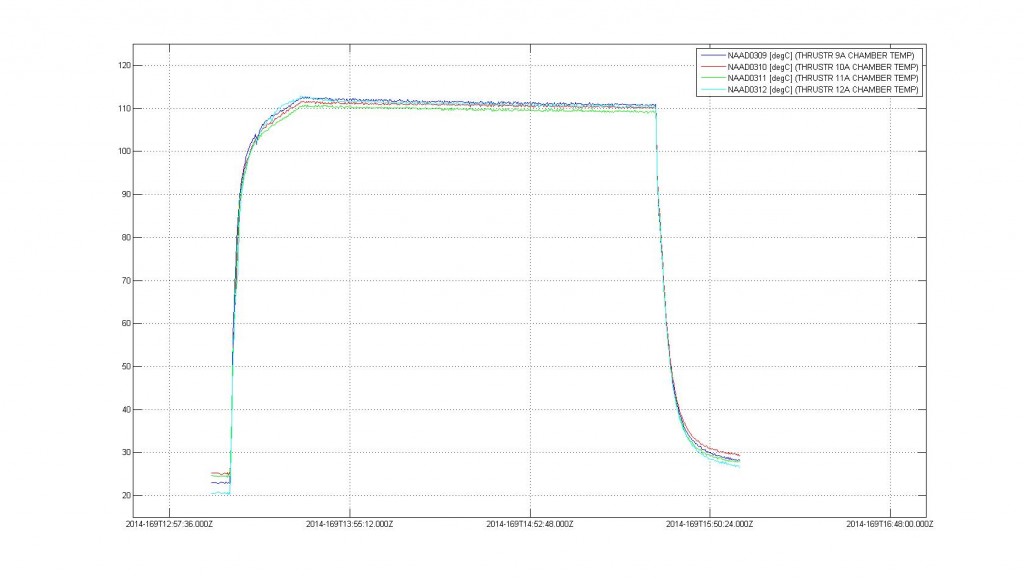Five down, five to go! We’re now half way through the rendezvous burn manoeuvres needed to put Rosetta on course with comet 67P/Churyumov-Gerasimenko, and tomorrow will check off the sixth.
Tomorrow’s burn is also the second of four so-called ‘Far Approach Trajectory’ (FAT) burns that are being conducted once a week in the period 2-23 July.
Last week’s FAT burn performed well: it ended about one minute earlier than expected but the target change in velocity of 58.7 m/s was achieved.
Now the team are looking ahead to tomorrow’s burn, which will get underway at 11:29:58 UTC (13:29:58 CEST) and is predicted to last 46 minutes 32 seconds. The one way signal travel time tomorrow will be 22 mins 51 seconds.
The team will be looking for the rise in thruster temperature to indicate that the burn has begun; similarly, a decrease indicates it is complete. The plot shown above is from the last of the three “big burn” manoeuvres, on 18 June.
Tomorrow’s burn will reduce Rosetta’s velocity relative to the comet by 25.7 m/s. In total, Rosetta has to slow down by 775 m/s to reach a relatively velocity of less then 1 m/s by 6 August.
Today, 8 July, there’s 25 000 kilometres between the spacecraft and the comet, and the relative velocity is 44.4 m/s; the remaining 18.7 m/s will be reduced in smaller and smaller increments between now and arrival. However, despite their diminishing size, the remaining burns are no less important; if no further manoeuvres were carried out, the closest approach to the comet would occur on 14 July at distance of 4912 km, that is, we would have a flyby!
We’ll let you know how the burn went as soon as we can afterwards via our twitter spacecraft @ESA_Rosetta. And we’ll have a new image of the comet to share on Thursday!
| Date | Delta-V m/s |
Dur. (mins) |
Comment |
| 7 May | 20 | 41 | Complete |
| 21 May | 290 | 441 | Complete |
| 4 Jun | 270 | 406 | Complete |
| 18 Jun | 91 | 140 | Complete |
| 2 Jul | 59 | 94 | Complete |
| 9 Jul | 26 | 46 | |
| 16 Jul | 11 | 26 | |
| 23 Jul | 5 | 17 | |
| 3 Aug | 3 | 13 | |
| 6 Aug | 1 | very brief |
More about the FAT burns in last week’s post: Burning down to comet rendezvous










Discussion: 12 comments
Could please somebody explain why a scheduled thruster burn can last more than a minute shorter “than expected”? What is the internal shut-off criterion? Obviousla it is not time but perhaps the measurement of a device on board?
Thank you for the great job in sharing your work with the similarly enthusiastic public!
Hi Matthias: This reply sent in by Armelle Hubault, on the team! Cheers…
There are accelerometers on board. When they measure that the programmed delta-V has been reached, they stop the manoeuvre. This is the reason why the real duration of the manoeuvre is always a little bit different from the expected duration. Since the thrusts are, overall, more performant than simulated, the actual manoeuvres are shorter than planned (the programmed Delta-V is reached earlier). Cheers, Armelle
Thanks for the update, Emily! Looking forward to tomorrow’s burn update and Thursday’s new image.
maybe Rosetta it is using th integral of the acceleretion to get the desired Delta-V as close as possible…(It is just an idea…)
Luca
I do love those posts.
It’s a little bit like being part of the team !
If you accept one little criticisim : it’s too bad that the 4 to 5 questions asked when an post is done almost never get an answer. We all understand that the team has a lot to do, but please consder our frustration 🙂
Anyway, WONDERFULL job, I can’t wait for Thursday pic. Thanks again
Serge/
Thanks Serge, and noted!
This burn – the sixth of ten – is now complete!
What resolution do the accelerometers have? Also, if you have accelerometers, why use the indirect temperature indication a burn has started, rather than the direct indication of acceleration?
first of all: great job!
I wonder a little bit that spacecraft state vectors did not change between VSTP 13 an 14 kernels. Same goes for the transition from VSTP 11 to 12.
From my understanding, there should be a refinement of position and attitude after Navigation-blocks. Why do you spend whole days on maintenance blocks for navigation when there is nothing to refine?
The relative speed of Rosetta toward 67P is now 66 km/h if I get it Right. But what is the speed of 67P (and thus Rosetta) on its orbit around the Sun right now (the comet should also go faster when it reaches its perihelion) ? Thanks
Rosetta is moving with 14.71 km/s in the sun-reference frame. Since it’s not moving directly to the sun, the (negative) rate of the distance is less: 9.37 km/s. You can calculate such things on https://wgc.jpl.nasa.gov:8080/webgeocalc/#StateVector
distance from comet 7-21-14 3300 mi
7-21-14 to 7-23-14 (us) 72 hr X 20mph ( 9 m’s) = 1400-800 mi
distance from comet 7/23/14 100-1500
7-23-14 to 8-3-14 = 264 hr X 9 mph (4 m/s) = 1056 mi
distance from comet 8/6/14 0-500mi